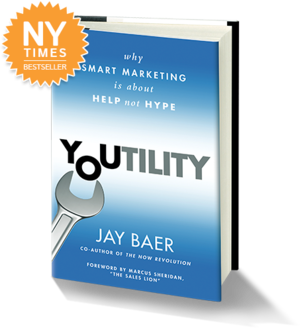Lara and I make an effort to attend at least two conferences a year each - not including the one we organize. Last week, I went down to Toronto to attend Mesh Marketing 2013. It was one of the best conferences I’ve attended for learning, with an engaged and really smart audience that added a lot to what the speakers talked about with their comments on social media. Everything I learned through the day is useful to any business that uses content marketing, however, the day ended with one of the best and most important messages.
 Jay Baer - our closing keynote speaker - is the author of the marketing blog, Convince and Convert, as well as the recent book, Youtility. Youtility is about creating something useful. (It isn’t necessarily about targeting a particular audience, but it needs to be relevant to your business.)
Jay Baer - our closing keynote speaker - is the author of the marketing blog, Convince and Convert, as well as the recent book, Youtility. Youtility is about creating something useful. (It isn’t necessarily about targeting a particular audience, but it needs to be relevant to your business.)
There are a number of ways that you can create useful content. Sharing tips, asking questions, and knowing the needs of your customers is a good start. But how can you take it a step further? How do you extend your reach?
Be useful. Be helpful.
One of the social media examples Jay shared was the @HiltonSuggests twitter account. This is what they do:
This twitter account doesn’t sell. It doesn’t do anything but help people by answering questions. And helping goes a long way. There’s not a great deal of effort required for any one person. This account is manned by employees all over the world. That’s pretty amazing. And what are the chances that someone who’s already travelling might remember the help they received and book with Hilton the next time they’re off on a trip? Probably significantly better than if @HiltonSuggests didn’t exist.
Most businesses don’t have the need or the resources for this kind of social media activity. But here are a few ways that you can create your own Youtility:
1) Answer common questions.
If your customers are asking you questions, verbally or in emails, you can bet many more are asking the same questions on google. Does your website answer the most frequently asked questions? Instead of building a FAQ page, start blogging those answers. We have semi-regular “how to” posts on our blog so that if someone wants to know how to sign up for twitter, they can find that information on our website.
2) Share indirect, but relevant information.
Every business has crossover with related businesses. We get asked for referrals to web designers/developers, graphic designers, and more. Neither of those disciplines is directly related to the work that we do. However, it’s absolutely relevant because it’s part of creating an effective web presence. I can share quality graphic and web design articles to help our audience learn more about something that is not in their area of expertise.
3) Promote your community.
We talk to a lot of social media users that don’t want to share personal information about themselves online. Sometimes, the reason is privacy; others it’s about keeping business and personal separate. We encourage being personable over being personal when the comfort level with sharing is low. When you don’t want to share things about yourself, you can build and encourage community by being a source of information about your area. (Community can mean a geographic area of any size or a common interest group - define it the way that works best for you.)
Committing to creating content that qualifies as “useful” can open the door for some really creative ideas that will serve your audience and grow your business. If you’re eager to learn more, be sure to pick up a copy of Youtility!
Do you have any examples of brands providing really useful information or services? Tell us in the comments!


